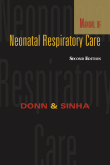|
|
|
| |
 |
|
|

|
 推薦指數:
推薦指數:





|
|
- 內容介紹
|
Manual of Neonatal Respiratory Care, 2nd Edition
By Steven M. Donn, MD and Sunil K. Sinha, MD, PhD FRCP FRCPCH
612 pages 112 ills
Trim size 6 X 9 in
Copyright 2006
Description
The Manual of Neonatal Respiratory Care offers a clear, clinical approach to all aspects of neonatal pulmonology! Access step-by-step guidance to normal lung development and physiology, cardiopulmonary assessment, neonatal respiratory failure, mechanical and conventional ventilation, commercial neonatal ventilators, high frequency ventilation, respiratory disease management, complications, pain, weaning, nursing care, procedures, pharmacologic agents, transport, alternative therapies, outcomes, and ethics. High quality radiographic images, figures, tables, algorithms, and case studies are also incorporated. Written and edited by international experts, this unique book is a must-have for any resident, fellow, respiratory therapist, nurse practitioner, or pediatrician working in the NICU.
Key Features
Practical approach to all aspects of neonatal respiratory care - Emphasis on “how-to” rather than theory provides readers with a fast, user-friendly guide to respiratory care including exam techniques, radiography, ventilation techniques, control of pain, intubation/extubation, transport, and discharge Outline format - Readers can quickly skim chapters and find needed information without wading through dense text explanations Small trim size - Convenient, on-the-go size fits easily in lab coat pocket for use at the bed- or ventilator-side Section on ventilator equipment - Condenses important information from unwieldy ventilator manuals, including voltage needed, modes, displays, and alarms for each machine Case studies - Real life clinical situations are presented, including differential diagnosis and radiograph examples. Helps readers to apply knowledge when presented with similar situations in their own NICU Global contributor base - International editor and contributor team adds global perspective of neonatal respiratory medicine and expands potential market size.
Table of Contents
Section I. Lung Development and Normal Pulmonary Physiology Ch. 1 Development of the Respiratory System Ch 2 Spontaneous Breathing Ch 3 Pulmonary Gas Exchange Ch 4 Pulmonary MechanicsSection II. Assessment of Cardiopulmonary Function Ch 5 Clinical Examination Ch. 6 Radiography Ch 7 Interpretation of Blood Gases Ch 8 Neonatal Graphic Monitoring Ch 9 Continuous Monitoring Techniques Ch 10 EchocardiographySection III. Neonatal Respiratory FailureCh 11 Indications for Mechanical VentilationCh 12 Mechanisms of Respiratory FailureCh 13 Tissue HypoxiaCh 14 Neonatal ResuscitationSection IV Mechanical VentilationCh 15 Basic Principles of Mechanical VentilationCh 16 Classification of Mechanical Ventilation DevicesCh 17 Ventilator ParametersSection V Conventional VentilationCh 18 Continuous Positive Airway PressureCh 19 Intermittent Airways Pressure Ch 20 Assist/Control VentilationCh 21 Synchronized intermittent Mandatory VentilationCh 22 Volume-Controlled VentilationCh 23 Pressure Support VentilationCh 24 Pressure Controlled Ventilation and Pressure Regulated Volume-Controlled VentilationSection VI Neonatal VentilatorsCh 25 VIP BIRD® Infant/Pediatric VentilatorCh 26 Dräger Babylog 8000 Plus ® Infant Care VentilatorCh 27 SLE 2000® (HFO) VentilatorCh 28 Sechrist Model IV-200 SAVI®Ch 29 Newport Wave® VentilatorCh 30 Bear Cub 750 PSV® Infant VentilatorCh 31 Siemens Servo 300® VentilatorCh 32 Infant Start® VentilatorSection VII Neonatal ApneaCh 33 Apnea SyndromesCh 34 Diagnosis of ApneaCh 35 Treatment of ApneaSection VIII High-Frequency VentilationCh 36 General Concepts of High-Frequency VentilationCh 37 High-Frequency Jet Ventilation and the Bunnell Life Pulse® High-Frequency VentilatorCh 38 High-Frequency Oscillatory VentilationCh 39 SoesorMedics 3100A® High-Frequency Oscillatory VentilatorSection IX Management of Specific Respiratory DisordersCh 40 Respiratory Distress SyndromeCh 41 Meconium Aspiration SyndromeCh 42 Neonatal PneumoniaCh 43 Persistent Pulmonary Hypertension of the Newborn Ch 44 Neonatal Pulmonary HemorrhageCh 45 Thoracic AirleaksCh 46 Congenital Diaphragmatic HerniaCh 47 Pulmonary HypoplasiaCh 48 Bronchopulmonary DysplasiaSection X. Complications of Mechanical VentilationCh 49 Airway and Respiratory Complications of Mechanical VentilationCh 50 Patent Ductus ArteriosusCh 51 Neurologic Complications of Mechanical VentilationCh 52 Retinopathy of PrematuritySection XI. Sedation and Control of PainCh 53 Assessment of Pain and SedationCh 54 Pharmacologic InterventionCh 55 Effects of Inadequate Analgesia or SedationSection XII. Weaning from Mechanical VentilationCh 56 Essentials of Weaning Ch 57 Weaning StrategiesCh 58 Adjunctive Treatments for WeaningCh 59 Impediments to WeaningCh 60 Extubation and Postextubation CareSection XIII. Nursing CareCh 61 Nursing DocumentationCh 62 Chest Physiotherapy/Postural DrainageCh 63 Endotracheal Tube SuctioningSection XIV Special ProceduresCh 64 Laryngoscopy and Endotracheal IntubationCh 65 Replacing the Endotracheal TubeCh 66 TransilluminationCh 67 Evacuation of AirleaksCh 68 Vascular AccessCh 69 BrochoscopyCh 70 TracheostomySection XV. Pharmacologic Agents Used in Respiratory CareCh 71 SurfactantsCh 72 Adjunctive Pharmacologic AgentsSection XVI. Transport of Ventilated BabiesCh 73 Transport EquipmentCh 74 Stabilization of the Transported NewbornCh 75 Special ConsiderationsSection. XVII. Alternative Therapies for Intractable Respiratory FailureCh 76 Extracorporeal Membrane OxygenationCh 77 Inhaled Nitric Oxide TherapyCh 78 Liquid Ventilation for Neonatal Respiratory FailureSection XVIII. Outcome of neonatal Intensive CareCh 79 Discharge Planning of the NICU GraduateCh 80 Follow-Up of the NICU GraduateSection XIX. Ethical ConsiderationsCh 81 Initiation of Life Support at the Border of ViabilityCh 82 Withdrawal if Ventilatory SupportSection XX. Ventilatory Case StudiesCh 83 Ventilatory Case Studies
|
|
|

